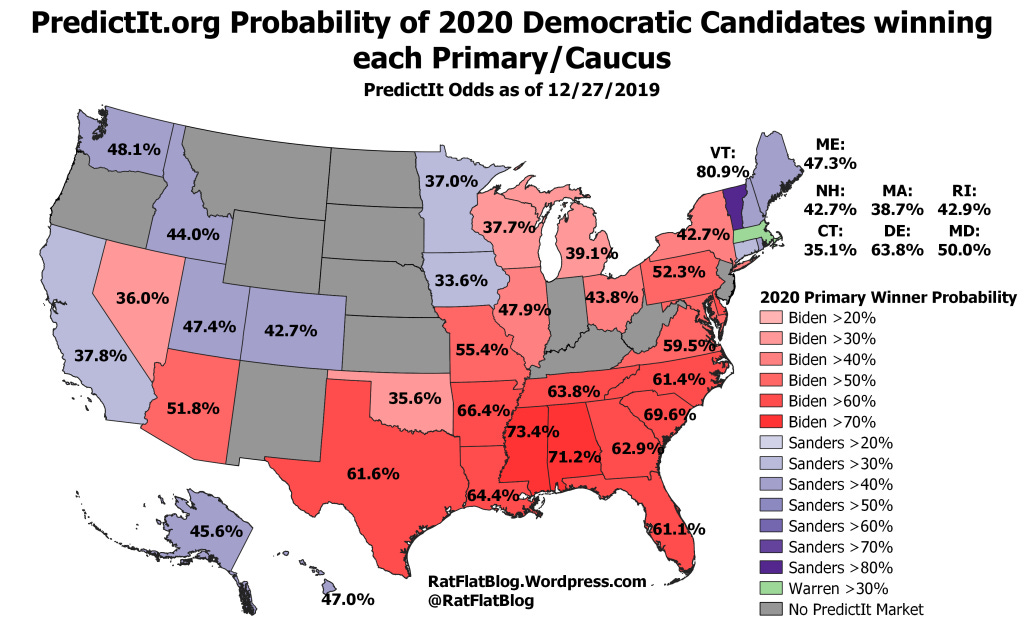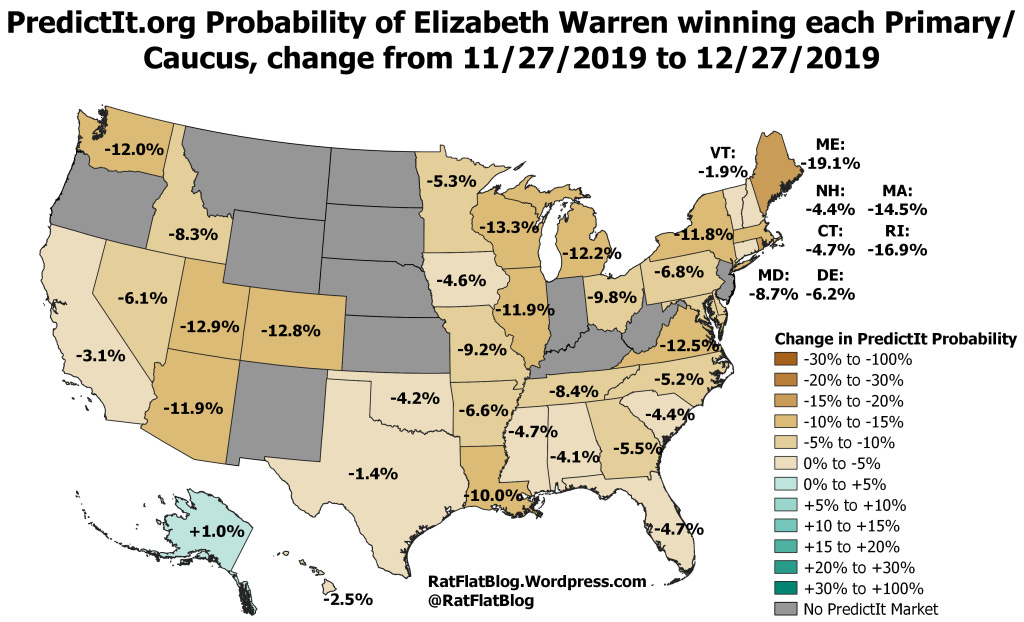Augur Weekly - How to Get a Head Start in the Primary Markets
A Look at the Week in Political Betting, Augur News, and More
Augur Weekly posts are public. If someone you know might like this content, please share it!
Election Betting Roundup
Happy New Year!
Today’s newsletter is a guest post by Millenerian (@ratflatblog), originally published on his blog, Rat Flat. Go give him a follow for the best in geographic visualizations of betting odds.
The past month has been kind to the candidacies of former Vice President Joe Biden and Senator Bernie Sanders, at least according to the gamblers on the political prediction website PredictIt.org. Last time I looked at PredictIt’s odds for the 2020 primaries and caucuses Mayor Pete Buttigieg led in Iowa and Senator Elizabeth Warren was favored in 3 North-East states. Since then both Buttigieg and Warren’s odds have dropped while Biden and Sanders’ odds have risen nearly across the board. As can be seen in the map below, Biden and Sanders now are favored in every state except Massachusetts, the home-state of Senator Elizabeth Warren. Note that several states with very late primaries do not yet have PredictIt.org markets set up yet, for example Montana which does not vote until June 2, 2020.

Joe Biden’s polling has been remarkably stable, and many political commentators felt he exceeded expectations in the last Democratic debate. Polls have shown him with solid support among black voters and working-class white voters, which may explain why his odds are above 60% in most southern states. Biden also shows strength in rust-belt states like Pennsylvania and Ohio, as well as South-Western states with large Latino populations such as Arizona and Nevada. His biggest vulnerability is his weak odds in the early voting states of Iowa and New Hampshire. He is only at 15% odds to win in each state, putting him behind both Sanders and Buttigieg. However, bettors seem to believe he can survive losses in these first two states, as he is a narrow favorite in Nevada, which is the third state to vote, and a heavy favorite in the final of the four early voting states, South Carolina.

Since November Biden has seen increases in his probability to win in every state except Vermont and Connecticut. Most promising for him are the signs of increasing strength in large, diverse, liberal states such as Illinois and New York, where he is now favored to win after being viewed as an under-dog to Sanders in November. More troubling for him is that his odds of winning have not increased much in Iowa, New Hampshire, and Nevada, with only ~5% increases in those early states. Losing both Iowa and New Hamsphire and then sweeping to victory in later states would be a fairly unique path to the nomination, but the bettors have faith in Joe at this point in the game.

Senator Bernie Sanders has also had remarkably stable polling and very strong fundraising, having bounced back after the scare of his October heart attack. His strength is concentrated in three regions: the North-East, the Upper Midwest, and the Pacific/Rocky Mountain West. He is solidly favored in New Hampshire, is a slight favorite in Iowa, and closely trails Biden’s odds in Nevada. However, he has very low odds in South Carolina, and this extends throughout the rest of the Southern United States, with the exception of Oklahoma and Missouri where he is more competitive.

Since November Sanders’ odds have increased in all but five states. His biggest increases have been in his strongest regions, with large jumps in states he won in 2016 like Maine, Minnesota, and Utah. He has seen smaller gains in the South and Rust-Belt, and has seen his odds drop in Arizona, Florida, Georgia, Illinois, and Pennsylvania. In these states increased confidence in Biden has eaten into Sanders’ odds. If he is going to win the nomination he will need to prove he can win in large diverse states, luckily for him he has gained ground in California, the largest prize in terms of delegates.

Mayor Pete Buttigieg still shows strength in the first state to vote, Iowa, but after that he is viewed as a long-shot in every state. PredictIt sees his best odds outside Iowa in New Hampshire, as well as other eastern states like Rhode Island, Maryland, and Ohio, along with a few western states such as Hawaii, Alaska, and Arizona. However, even in these states his odds rarely get very far above 10%. His weakest region is the South, where he is under 10% odds to win in every state but Florida.

In November Buttigieg was riding high, but since then his polling has dipped and he has come under withering attacks from rival campaigns. His odds have dropped across the board, but most damaging are his 10% drop in Iowa and New Hampshire, which has placed him firmly in second-place in those states behind Senator Sanders.

Senator Elizabeth Warren has seen her polling drop significantly since November, which has sapped her strength across the country in PredictIt markets. Her best areas are still the North-East and the West, but she is now below 15% odds in every state but her home-state of Massachusetts. Her weakest areas are in the South and the Rust Belt, where her strongest demographic, college-educated white voters, make up a smaller share of the Democratic primary electorate.

Warren’s odds have dropped in every state across the board, with the exception of Alaska where she saw a small increase. The biggest decreases have come in states with more liberal democratic primary electorates like Maine, Wisconsin, Colorado, and Washington. These are states that Bernie Sanders won in 2016, and her odds have dropped here while his have risen steeply.

So overall, according to PredictIt the shape of the 2020 Democratic Primary is increasingly looking like a head-to-head battle between Joe Biden and Bernie Sanders. Sanders is favored in the early states of Iowa and New Hampshire, but Biden is favored in Nevada and South Carolina along with the South, the Rust Belt, and big states like Illinois and New York. If PredictIt is right, this would suggest that Biden is the most likely nominee, unless Bernie can ride the momentum from those early states to win over diverse liberal states like New York and Illinois that he lost to Hillary Clinton in 2016.
Personally, my own view is that the race is more wide-open than what is suggested by PredictIt’s markets. Biden and Sanders have had stable polling, but neither have had a large surge in support as Warren and Buttigieg have faded. This suggests there are still many voters who are undecided, and could shift back to Warren or Buttigieg if they were to do well in the early states. Warren and Buttigieg still have strong fundraising, and supposedly have the strongest organizations in Iowa, which is particularly important as it is a caucus state.
My next update will be in late January of 2020, just before the Iowa caucuses. It will be very interesting to see if PredictIt still shows a battle between Biden and Sanders, or if the odds have shifted back towards other candidates.
As a reminder, come Q1 2020, Augur will be the only platform for political betting with no limits, the lowest fees, and unbeatable odds.
To receive updates on Augur including this newsletter, sign up below:
Further Reading:
Don’t Expect Too Many Polls - Political Alert Engine
Around the Ecosystem
More on Augur
Augur v2: A Tour of the Prediction Protocol’s First Major Upgrade
The Ultimate Guide to Decentralized Prediction Markets
Announcing the Augur v1 Cutoff
The Forecast Foundation has no role in the operation of markets, trades or actions created or performed on the Augur protocol, nor does it have the ability to censor, restrict, control, modify, change, revoke, terminate or make any changes to markets created on the Augur protocol. The Forecast Foundation has no more control over the Augur protocol than anyone else using Ethereum.
Thus, we do not seek to advise others on how to use the protocol. We encourage those in the community who are well educated on Augur to pay it forward and share their ideas for best practices, tips, fixes, etc with the larger community via Twitter, Discord, Reddit, Github, and other community channels. For more information regarding the role of the Forecast Foundation, check out the FAQ.

